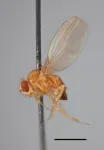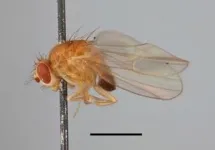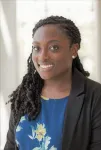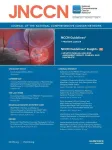(Press-News.org) Back when the biggest fly enthusiasts of 19th century Sweden — Carl Fredrik Fallén, for one, and later Johan Wilhelm Zetterstedt — were collecting insects for what would become Lund University’s entomological collections, they wondered exactly what was that buzzing coming from their can of raisins.
Skip forward 200 years, and the humble fruit fly, known better to geneticists as Drosophila melanogaster, is one of the most thoroughly studied animals on the planet. And DNA from Fallén and Zetterstedt’s centuries-old curiosities are still revealing new insights into the fly’s evolution as it spread alongside people to new parts of the world.
Researchers from the University of Wisconsin–Madison and Lund University extracted and analyzed DNA from fruit flies housed in museum collections in Lund, Stockholm and Copenhagen. The flies are museum specimens collected by naturalists in Europe as early as the first decade of the 19th century and as recently as the 1930s.
The early fly-finders considered any insects they could get their hands on worth keeping — Fallén’s specimens indeed include some that appear to have been enjoying his raisins — but they probably couldn’t have conceived of Drosophila’s importance to science.
“This species has been a key player in basic biological science for well over a century now,” says John Pool, UW–Madison professor of genetics. “We've turned to it to learn things about the basic rules of life, what genetic variation looks like in natural populations, how different evolutionary forces shape diversity. And that’s just in my field.”
That means the genes of fruit flies may have been sequenced, catalogued and described more often than any other animal. But those samples came from modern specimens. Because a fruit fly lives about 50 days, the new DNA samples — described in a study published today in the journal PLOS Biology — come from some very ancient relatives of the flies buzzing around our fruit bowls these days.
“It’s not so unusual to get useful DNA from very old specimens of our hominid ancestors or other animals,” Pool says. “But the number of generations — about 3,000 — that have elapsed in fly populations since some of these we’ve sequenced were alive is about the same number of our generations since humans emerged from Africa.”
Lund zoologist Marcus Stensmyr recovered genetic material from the museum flies by soaking them in a solution that breaks open cell membranes to free up large molecules inside. The flies were washed and dried and returned to the museum collection. Their DNA was extracted from the solution and analyzed at UW–Madison.
Surprisingly, the researchers found the fruit flies collected in Sweden in the early 1800s were more genetically similar to 21st century flies than the Swedish samples from the 1930s. That’s likely due to the older flies’ place in Drosophila history as some of the first arrivals so far north of their original range in Southern Africa. For some time, they were a small outpost, in which random mutations would make larger differences in the population — more of what’s called “genetic drift” — as the 1800s became the 1900s. Swedish flies would get less unique, though, when their numbers were reinforced from the broader European gene pool.
“There would have been a vast increase in fruit shipping between the 1930s and the present and, generally, more human transport that probably increased opportunities for longer distance Drosophila migration,” Pool says. “So, what we think we are seeing between the 1930s and the present is the effect of that migration basically homogenizing genetic variation.”
By comparing changes across the centuries of fly samples now at their disposal, the researchers also identified a handful of genes showing signs of evolutionary pressure.
“That was a key interest of our study, to try to figure out which genes may have been the most important in helping this fly population adapt to very novel climate and a novel environment,” Pool says.
Differences between DNA from 1930s specimens and their present-day kin revealed the emergence of a gene called Cyp6g1 that’s known now to make the flies more resistant to the pesticide DDT.
“That was our top result for the more recent time interval,” Pool says. “And that made perfect sense, in terms of when DDT was introduced.”
That would be in the 1940s, not long after the study’s most recent museum sources of Drosophila were still airborne. Earlier than that, important genetic shifts show a gene called Ahcy aiding the 19th century flies’ adaptation to cooler temperatures and shorter days — important factors in the fly’s reproductive cycles — in Sweden (and other high-latitude homes).
Another gene, ChKov1, was thought to be insecticide-related, but DNA from museum flies collected in the 1800s showed that the gene evolved before the relevant insecticides were even invented. Previous work by other researchers had suggested ChKov1 also conferred resistance to a virus, called sigmavirus, believed to have appeared in flies about 200 years ago.
“Our results strongly favor the viral resistance hypothesis over the insecticide resistance hypothesis,” Pool says. “So, that’s an example of a gene that was already suggested to be under natural selection, but we learned some new things about it by having these temporal samples.”
It’s a testament to both the work done long ago by curious scientists breaking new ground in their field and present-day practitioners using modern technology to much the same effect.
“This is an example of what millions of museum specimens all around the world could tell us about the changes that have taken place in many different species,” says Pool.
END
200-year-old DNA helps map tiny fly’s genetic course to new lands, modern times
The humble fruit fly is one of the most thoroughly studied animals on the planet and new insights continue to be revealed about the fly’s evolution thanks to centuries-old DNA
2023-10-12
ELSE PRESS RELEASES FROM THIS DATE:
Study highlights concerns and preferences of residents regarding police involvement in mental health crisis response
2023-10-12
PHILADELPHIA (October 11, 2023) – Police officers often respond to incidents that do not involve crime or immediate threats to public safety but instead deal with community members facing unmet mental health needs. In response to this, many cities are experimenting with co-deploying police officers alongside health professionals or deploying teams entirely composed of civilian health professionals.
Recently, researchers from the University of Pennsylvania School of Nursing (Penn Nursing) explored the perspectives and preferences about these programs among residents in structurally disadvantaged areas where mental health distress is ...
More Aggressive treatment doesn’t impact quality of life for metastatic colorectal cancer patients, according to new study in JNCCN
2023-10-12
PLYMOUTH MEETING, PA [October 12, 2023] — New research in the October 2023 issue of JNCCN—Journal of the National Comprehensive Cancer Network finds that intensive local-regional treatment to remove as much tumor as possible (known as “debulking”), in addition to standard systemic therapy, does not impact overall quality of life significantly for people with metastatic colorectal cancer.
The researchers examined the ongoing ORCHESTRA trial (NCT01792934) to compare patients treated with standard palliative chemotherapy alone to those who received palliative chemotherapy plus either surgery, ablative therapy, and/or radiotherapy ...
Honey bees may inherit altruistic behavior from their mothers
2023-10-12
UNIVERSITY PARK, Pa. — True altruism is rare behavior in animals, but a new study by Penn State researchers has found that honey bees display this trait. Additionally, they found that an evolutionary battle of genetics may determine the parent they inherit it from.
For the study, published in the journal Molecular Ecology, the researchers examined the genetics behind “retinue” behavior in worker honey bees, who are always female. After the worker bees are exposed to the queen bee’s pheromone, they deactivate their own ovaries, help spread the pheromone to the other worker bees, and tend to the queen ...
Researchers develop technology to tabulate and characterize every cell in the human brain
2023-10-12
BOSTON – The brain is made up of numerous types of cells that are organized into different structures and regions.
Although several important steps have been made towards building models of the human brain, the advances have not produced undistorted 3D images of cellular architecture that are needed to build accurate and detailed models.
In new research published in Science Advances, a team led by investigators at Massachusetts General Hospital (MGH), a founding member of Mass General Brigham (MGB), has overcome this challenge to offer scientists and clinicians a comprehensive cellular atlas of a part of the human brain known as Broca’s area, with ...
Americans will spend half their lives taking prescription drugs, study finds
2023-10-12
UNIVERSITY PARK, Pa. — An American born in 2019 will spend a larger share of their lifetime taking prescription drugs than being married or receiving an education, according to new research by Jessica Ho, associate professor of sociology and demography at Penn State. She found that American males will spend approximately 48% of their lives taking prescription drugs. The number jumped to 60% for females.
Ho reported her findings this week (Oct. 1) in the journal Demography.
“As an American, I’d like ...
Advertising rental housing in Spanish puts off many potential renters
2023-10-12
Publishing an ad for an apartment or rental home in Spanish may seem like it would broaden the pool of potential renters, but new research shows it can harm rental-seekers’ perception of the property and its neighborhood.
Finding a new apartment or home to rent can be nerve-wracking and tedious. It is increasingly digital and there are thousands of websites and Facebook groups for prospective renters to peruse. It can be a fraught endeavor — from vetting Craigslist listings to scrolling through hundreds of different listings to find the ...
Scientists generate first single-cell “atlas” of the primate brain to help explore links between molecules, cells, brain function and disease
2023-10-12
A longstanding mystery in science is how the over 100 million individual neurons work together to form a network that forms the basis of who we are – every human thought, emotion and behavior.
Mapping these constellations of cells and discovering their function have been long-standing goals of scores of 21st century molecular cartographers working worldwide as part of the National Institutes of Health’s “Brain Initiative Cell Census Network” project. The overarching ...
Researchers construct first “multiome” atlas of cell development in the human cerebral cortex from before birth to adulthood
2023-10-12
A team of researchers from the Icahn School of Medicine at Mount Sinai and Yale University School of Medicine has created the first “multiome” atlas of brain cell development in the human cerebral cortex across six broad developmental time points from fetal development into adulthood, shedding new light on their roles during brain development and disease.
“Multiome” refers to the simultaneous analysis of multiple types of genetic information within the same biological sample. They can include the genome, the DNA encoded in our cells; the transcriptome, the RNA copies that the cell makes from the ...
Boom-and-bust cycles in grey whale population associated with changing Arctic ecosystem
2023-10-12
Even highly mobile, large, and long-lived species are sensitive to dynamic and changing conditions as the Arctic warms. A new study reports that population swings in eastern North Pacific grey whales – some of which have resulted in recent mass mortality events – are driven by changing prey biomass and ice cover in the Arctic. Climate change is driving rapid change in Arctic ecosystems, including the highly productive shallow basins of the Pacific Arctic, which are critical marine areas that support seasonal foraging opportunities for various migratory marine species. While climate impacts affect lower-trophic level and short-lived species most directly, ...
About 2 million years ago, Homo Erectus lived at high altitudes and produced both Oldowan and Acheulean tools
2023-10-12
Two million years ago, Homo erectus had expanded beyond the lowland savanna environments of East Africa and into the high-altitude regions of the Ethiopian highlands, where they produced both Oldowan and Acheulean tools, according to a new study. It presents a reanalysis of an early hominin fossil first discovered in 1981. The findings provide novel insights into the evolution, migration and adaptive capacities of early human ancestors. In Africa, the limited number of hominin fossils found in direct association with stone tools has hindered attempts to link Homo habilis and Homo erectus with ...
LAST 30 PRESS RELEASES:
The Ceramic Society of Japan’s Oxoate Ceramics Research Association launches new international book project
Heart-brain connection: international study reveals the role of the vagus nerve in keeping the heart young
Researchers identify Rb1 as a predictive biomarker for a new therapeutic strategy in some breast cancers
Survey reveals ethical gaps slowing AI adoption in pediatric surgery
Stimulant ADHD medications work differently than thought
AI overestimates how smart people are, according to HSE economists
HSE researchers create genome-wide map of quadruplexes
Scientists boost cell "powerhouses" to burn more calories
Automatic label checking: The missing step in making reliable medical AI
Low daily alcohol intake linked to 50% heightened mouth cancer risk in India
American Meteorological Society announces Rick Spinrad as 2026 President-Elect
Biomass-based carbon capture spotlighted in newly released global climate webinar recording
Illuminating invisible nano pollutants: advanced bioimaging tracks the full journey of emerging nanoscale contaminants in living systems
How does age affect recovery from spinal cord injury?
Novel AI tool offers prognosis for patients with head and neck cancer
Fathers’ microplastic exposure tied to their children’s metabolic problems
Research validates laboratory model for studying high-grade serous ovarian cancer
SIR 2026 delivers transformative breakthroughs in minimally invasive medicine to improve patient care
Stem Cell Reports most downloaded papers of 2025 highlight the breadth and impact of stem cell research
Oxford-led study estimates NHS spends around 3% of its primary and secondary care budget on the health impacts of heat and cold in England
A researcher’s long quest leads to a smart composite breakthrough
Urban wild bees act as “microbial sensors” of city health.
New study finds where you live affects recovery after a hip fracture
Forecasting the impact of fully automated vehicle adoption on US road traffic injuries
Alcohol-related hospitalizations from 2016 to 2022
Semaglutide and hospitalizations in patients with obesity and established cardiovascular disease
Researchers ‘listen in’ to embryo-mother interactions during implantation using a culture system replicating the womb lining
How changing your diet could help save the world
How to make AI truly scalable and reliable for real-time traffic assignment?
Beyond fragmented markets: A new framework for efficient and stable ride-pooling
[Press-News.org] 200-year-old DNA helps map tiny fly’s genetic course to new lands, modern timesThe humble fruit fly is one of the most thoroughly studied animals on the planet and new insights continue to be revealed about the fly’s evolution thanks to centuries-old DNA





